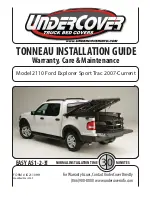
WHEELS AND TIRES
471
Tread wear indicator
The tires have wear indicator strips running
across or parallel to the tread.
The letters TWI are printed on the side of the tire.
When approximately 1/16" (1.6 mm) is left on
the tread, these strips become visible and indi-
cate that the tire should be replaced. Tires with
less than 1/16" (1.6 mm) tread offer very poor
traction.
When replacing worn tires, it is recommended
that the tire be identical in type (radial) and size
as the one being replaced. Using a tire of the
same make (manufacturer) will help prevent
alteration of the driving characteristics of the
vehicle.
Related information
•
Tire direction of rotation (p. 470)
•
Checking tire inflation pressure (p. 473)
Loading specifications
Properly loading your vehicle will provide maxi-
mum return of vehicle design performance.
Weight designations
Before loading your vehicle, familiarize yourself
with the following terms for determining your
vehicle's weight ratings, with or without a trailer,
from the vehicle's Federal/Canadian Motor Vehi-
cle Safety Standards (FMVSS/CMVSS) label, and
the vehicle's tire information placard:
Curb weight
The weight of the vehicle including a full tank of
fuel and all standard equipment. It does not
include passengers, cargo, or optional equipment.
Capacity weight
All weight added to the curb weight, including
cargo and optional equipment. When towing,
trailer hitch tongue load is also part of cargo
weight.
Permissible axle weight
The maximum allowable weight that can be car-
ried by a single axle (front or rear). These num-
bers are shown on the Federal/Canadian Motor
Vehicle Safety Standards (FMVSS/CMVSS) label.
The total load on each axle must never exceed its
maximum permissible weight.
Gross vehicle weight (GVW)
The vehicle's curb cargo + passengers.
Steps for Determining Correct Load Limit
1. Locate the statement "the combined weight
of occupants and cargo should never exceed
XXX pounds" on your vehicle's placard.
2. Determine the combined weight of the driver
and passengers that will be riding in your
vehicle.
3. Subtract the combined weight of the driver
and passengers from XXX kilograms or XXX
pounds.
4. The resulting figure equals the available
amount of cargo and luggage load capacity.
For example, if the "XXX" amount equals
1400 lbs. and there will be five 150 lb. pas-
sengers in your vehicle, the amount of availa-
ble cargo and luggage load capacity is
650 lbs. (1400 – 750 (5 × 150) = 650 lbs.)
5. Determine the combined weight of luggage
and cargo being loaded on the vehicle. That
weight may not safely exceed the available
cargo and luggage load capacity calculated
in Step 4.
6. If your vehicle will be towing a trailer, load
from your trailer will be transferred to your
vehicle.
Summary of Contents for XC 90 2016
Page 1: ...WEB EDITION OWNER S MANUAL...
Page 2: ......
Page 14: ......
Page 15: ...INTRODUCTION...
Page 57: ...SAFETY...
Page 93: ...INSTRUMENTS AND CONTROLS...
Page 176: ......
Page 177: ...CLIMATE...
Page 200: ......
Page 201: ...LOADING AND STORAGE...
Page 217: ...LOCKS AND ALARM...
Page 241: ...DRIVER SUPPORT...
Page 331: ...STARTING AND DRIVING...
Page 376: ......
Page 377: ...INFOTAINMENT...
Page 415: ...VOLVO ON CALL WITH SENSUS CONNECT...
Page 429: ...NAVIGATION...
Page 466: ......
Page 467: ...WHEELS AND TIRES...
Page 488: ......
Page 489: ...MAINTENANCE AND SERVICING...
Page 535: ...SPECIFICATIONS...
Page 537: ...SPECIFICATIONS 535 Location of labels...
Page 549: ...HOTSPOTS...
Page 550: ...HOTSPOTS 548 Centerdisplay App view Centerdisplay Car functions view Instrument panel...
Page 551: ...HOTSPOTS 549 Driver s door panel Engine compartment Exterior...
Page 552: ...HOTSPOTS 550...
Page 553: ...HOTSPOTS 551 Center display and tunnel consol...
Page 554: ...HOTSPOTS 552 Interior rearview mirror Interior...
Page 555: ...HOTSPOTS 553...
Page 556: ...HOTSPOTS 554 Remote key Trunk...
Page 568: ...566...
Page 569: ......
















































